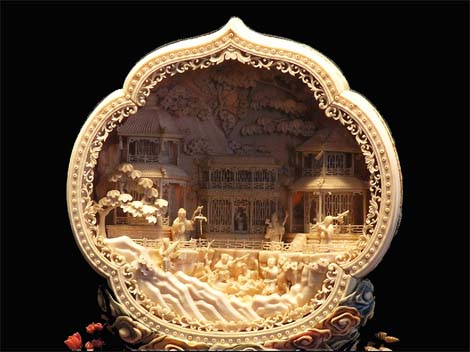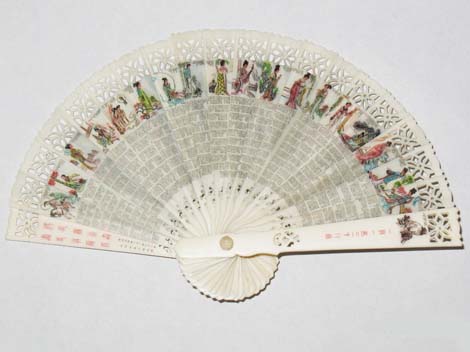

The art of micro-carving refers generally to the engraving of infinitesimal characters on ivory or human hair. The artist engaged in this unique craft, when he applies the graver, cannot see the work he is doing but has to rely on feel.The art is therefore sometimes described as "carving by one's will".
There are in many cities of China such microsculptors, who can engrave on small grains of ivory poems, paintings and miniature seal marks in no less than 10 different colours.
Zhang Yunhu,a micro-callingrapher of Shanghai, on a piece of ivory 3 cm square, reproduced the whole anthology of The
Three Hundred Tang Poems, totalling more than 10,000 characters.To the naked eye, the words are just rows upon rows of black needlepoint etchings.
In 1982, he came out with another marvel--the complete text in 14,000 characters of the Constitution of the Chinese Communist Party on a chip of ivory 2.8 cm square. This he did only in two weeks. Viewed under a microscope with a magnification of 100, the characters can be seen to be composed of elegant, clear and fine strokes.
Micro-carving on human hair is a new art developed only in recent years, being pioneered by Shen Weizhong, a member of the Suzhou Arts and Crafts Research Institute. On a hair several mm long and without the help of any magnifying apparatus, the artist can engrave poems or other texts by relying upon the feel of his fingers. To achieve this, he needs an absolutely quiet environment, in which, holding his breath and controlling his pulse by meditative power, he plies his art with a cutting wire thinner than the hair. To read the surprisingly neat characters on the finished work, it is necessary to magnify them several dozen times with a microscope.
Hair carving has been developed on the basis of fine-character carving, which has always been a Chinese tradition. Its rudiments may be traced back to more than 2,000 years ago. On the fragments of oracle bones of the Western Zhou period, unearthed in Guyuan, Shaanxi Province, have been found small carved characters the size of rice grains with hair-thin strokes. Archaeologists have also found on the much earlier Yin oracle shells miniature engravings the size of millet, legible only under 5-fold magnification.
Artists of today with their assiduous study and experiment have given the age-old art a new lustre.





